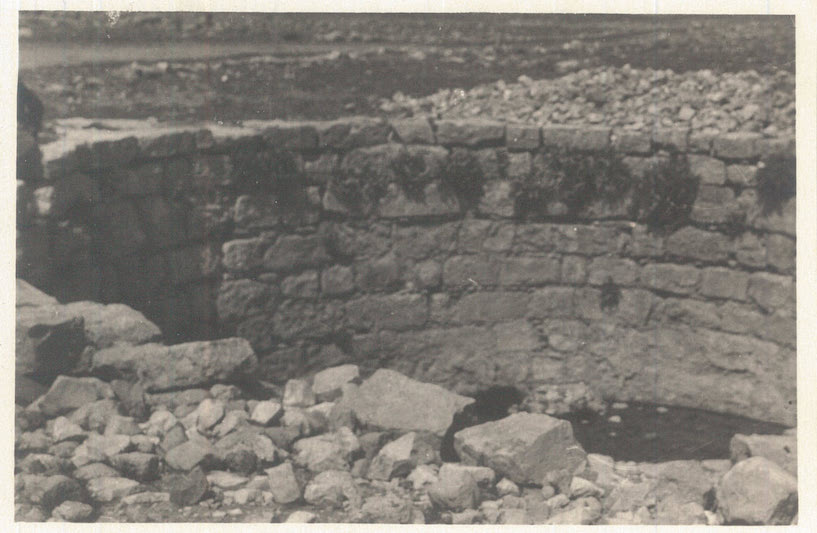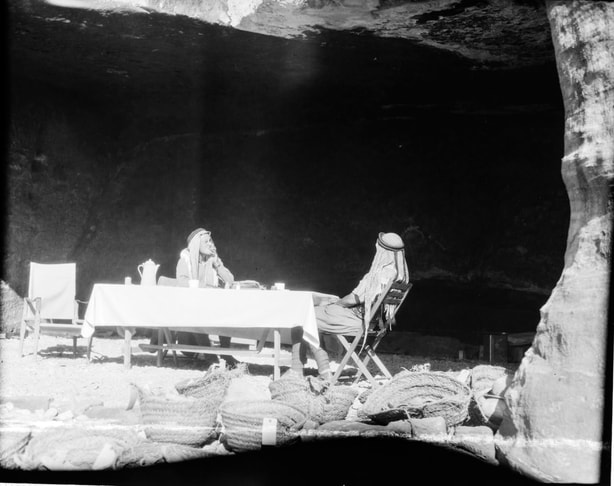|
[probably by Agnes Conway] Dr. Nielsen and A.E.C. left early, arriving at Petra for lunch, and had to put up at [Thomas] Cook’s Camp, our own not being ready. The Circassians from Jerash and local Arabs worked hard all day, under Mr. Horsfield’s direction, clearing out caves and building an oven. Mr Horsfield, Dr. Nielsen and A.E.C. climbed the mounds of the Roman city to see the points at which Mr H. had decided the dig should be begun. Dr. N. & A.E.C. photographed and examined the well at El Basta on the way down, which seems to be Roman and is very large and well-built. Reference: [unsigned, but probably Conway, A.] 1929 (transcribed by A. Thornton). Petra Exploration Fund Diary. "Business Papers to be Kept", Horsfield Collection Box 8, UCL Institute of Archaeology, 23 March: 3.
[by Agnes Conway and George Horsfield] Dr. Nielsen spent the day working at the Sanctuaries on El Habis, and felt that he had discovered enough in one morning to justify his journey. This complex of cult monuments, all orientated to the west, seem to him to be the earliest Arabian sanctuaries, circa the 2nd millennium B.C. He thinks that the bulls heads on the so-called “pulpit” and the cone shaped top, somewhat resembling a coil, of snakes, are of human workmanship, though much weathered. (He turned this down afterwards). A.E.C. spent the morning and afternoon exploring the Wady El Tughra. Below El Habis, S of the sanctuaries, she found what might almost be called a cemetery of shaft graves, some leading into large tomb chambers below. All were of solid construction and considerable depth, but the roofs in all cases had gone and the contents were rifled. One shaft grave had 3 small detached obelisks near it, and the holes for the bases stood at the head of the grave 1. The graves on the opposite side of the Wady under El Bijara are much later. Two sumptuous Nabataean temple graves have later partition walls of large stones, regularly built (prob. Bedouin?). One large tomb with a niche for a single grave has only a small hole knocked out of the slab and might be worth exploring for its contents. Following the Wady southwards a large irregular lump of sandstone in the middle (the Kegelberg) is also a collection of shaft graves, and further on on the western side are a few shaft graves in front of some of the largest Hellenistic tombs. The green plateau between the Wady and the W. face of El Biijara is a mass of large worked stones, probably Greco-Roman and looked to her like remains of the town. Where the Wady en Mer runs into the Wady el Tughra are a few rock-hewn caves, almost entirely silted up with sand, which might be worth excavation. G. H. started digging in mound S.W. Zubb Pharoon [sic], on the part that lies above Dalmans [sic] “Byzantine” Wall. It is covered with Byzantine pottery but the steps cut in the side of the mound produced very little. The mound in this part is composed of sand and a certain amount of burnt debris, probably from wood fires, but contained no charcoal. The sand is loose and the digging had to be done with caution for fear of a land slide. In the afternoon moved further South, where the debris is deep, and higher up the mound, which is apparently surmounted by a fortified wall which is not shown in Dalman’s plan. It breaks out from the Byzantine wall then turns until it meets the rock, with a shaft tomb. Below this lies another with slabs in place, one being broken so that you can peer in. It is partially filled with debris, and seems to have a chamber on either side. The pottery finds were poor, but a deep cutting may be interesting. The evidence so far obtained points to the wall being pre-Byzantine, as it is buried in debris of this period. Today the Camp was finished. It is situated in the Wadi Deir, in caves on both sides. In the West is the cookhouse, Living Room, W.C. and stables, and beyond a Bathroom. Dr Nielsen and Miss Conway are accommodated in tents. On the East is the Guardroom, which is also used as a Store House; adjoining is a small cave for G.H. and next door is the Guest Room. It is fairly compact, and the guard room covers all points of approach.
Many deficiencies have been discovered in the equipment, which was reduced as much as possible. These are being taken in hand, and Thos. Cook and Son’s camp, in the person of the Manager, has been most helpful. It is impossible to buy anything at Elgi, except the poorest things. No vegetables are obtainable. Milk is procurable. Chickens and sheep have to be got from the Arabs some miles away. Arrangements are beginning to work, so that all the attention of the Expedition may be given to the work of exploration. __ [Footnote]: 1. These are probably not holes for obelisks, but the ordinary ones for offerings. Mr Horsfield excavated these shaft graves later on. Reference: [unsigned, but by Agnes Conway and George Horsfield] 1929 (transcribed by A. Thornton). Petra Exploration Fund Diary. "Business Papers to be Kept", Horsfield Collection Box 8, UCL Institute of Archaeology, 26 March: 6-9. [By George Horsfield] G. H. Went to El Barid in 1 ½ hours and explored the site and surroundings. The site has Hadrianic monuments and innumerable cisterns and contrivances for catching and holding water. To the west is a stair in a nick in the rock which is almost blocked at the top; beyond it descends into the Wadi which falls to the West. Higher up east is another which falls S.W., so this is the head of the Water shed. To the East outside are many Bedouin graves outlined with stones and 2 built ones – one of which was roughly roofed in – with a small low door to W. This area has apparently been built on – all the rocks surrounding contain cisterns – some of large size. There are extensive quarries and the stone seems of good quality and similar to that used in the 2nd century Petra buildings. To the North is a wider wadi which has the remains of walls extending the whole width one behind the other – on North side is a building and another in the NW Angle: the second court or serai is approached from the E. side and a wall cuts off a passage about 5 m. wide towards the cliff. Probably a caravanserai for camels and pack mules for bringing stones to Petra. At 11.15 Drifullah brought news of an accident to one of the workmen who had his leg broken at the thigh by a fall of earth. He sat under the working face at the breakfast interval, and a short time before the whistle blew a heavy fall buried him and another man - who escaped injury. Dr Canaan returned; found the man in the police tent at Cooks Camp and set the leg. On my instruction he offered to send the man to Amman to Hospital; it was repeated several times, but he preferred to stay in the village. It is a simple fracture of the thigh. Dr Canaan improvised a stretcher – and the man was carried to his house. The digging continued, the pottery same as before with one inscribed jar handle. The lower depth is being attacked – so the depth is now six metres.
Reference: Horsfield, G. 1929 (transcribed by A. Thornton). Petra Exploration Fund Diary. "Business Papers to be Kept", Horsfield Collection Box 8, UCL Institute of Archaeology, 10 April: 30-31. [By George Horsfield and possibly Agnes Conway]
G. H. Cold after rain and snow, a slight fall of snow on the mountains to S.E. Visitors to Cooks Camp can’t move, as all the roads are impassable. The digging at No. 2. cave has cleared the front “court” and part of the inside. A Byzantine rubbish tip was found 50 cents. below surface. Below that more pottery and the head of a Figurine with a late 1st century A.D. type of hairdressing. Certain pieces of whitish grey green pottery are new, one piece has a pattern on its handle which looks like two wriggling snakes. The court has steps round it – and the floor is unique – but as it is not yet cleaned up it is difficult to make out – it seems to have channels cut in it, and may be the result of quarrying! No. 3. cave is uninteresting – pottery Byzantine and gives no promise. Dug out 2 Xtian ? tombs opposite Turkomaniya – both empty except one which had 3 small fragments of bone. The underpart of the grave box in both cases was straight on the earth. In afternoon went down Siyagh with Dr. N. and Miss C to visit the houses of which it is full. Up on the W side of Deir found 3 early and interesting rooms, - the one with Nab. inscriptions being particularly interesting – it was a [? In pencil] with rounded end. Pottery in vicinity Byz. The plateau leading to these rooms has about 50 cents. of sandy earth on it. The so-called Sanctuary is not a Sanct. Finished afternoon at dig – nothing new. The door to chamber is built of masonry inserted into the red sandstone; also the cill of door. The masonry is rough chiselled, with margins about 3 cents. wide. The Siyagh and el Ma’aisera I think are certainly, with Habis, the oldest part of the city – but our exploration is hardly sufficiently advanced to make deductions from the evidence available. Continued sorting of pots. A.E.C. went with 3 men to dig the 2 chambers seen yesterday in the engaged pillar tomb N. of the Tomb of the Urn. Though the S. one rang hollow, there was nothing but 1 ½ ft of manure on a stone floor. The pottery was Bedouin with one small fragment of Greco-Roman. In the N room there was nothing at all; but the tomb chamber, of the size of a shaft grave, seems to have been on the upper floor, and the purpose of the 2 small, beautifully squared chambers on the ground floor, is still unknown. Mahmud climbed to the top of the 4 sacrophagi bases in the Palace Tomb and picked among the divisions; but there was nothing new to be seen. A.C. found a view point in the Siyagh from which 9 tiers of houses on El Habis can be distinguished. There are however tombs as well, and the hill-side is still a puzzle. The shaft-grave complex at the S.W. end is at the back of what must once have been a huge row of Nabataean tombs along the edge of the Wady Tuglera. These seem to have been quarried and to have fallen down and their relation to the shaft graves behind them I cannot fathom. (These lead into them from the top). Reference: Horsfield, G. [and possibly Conway, A.] 1929 (transcribed by A. Thornton). Petra Exploration Fund Diary. "Business Papers to be Kept", Horsfield Collection Box 8, UCL Institute of Archaeology, 22 April: 49-51. |
Categories
All
Archives |



 RSS Feed
RSS Feed